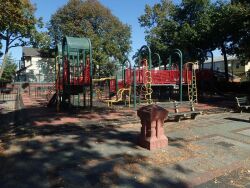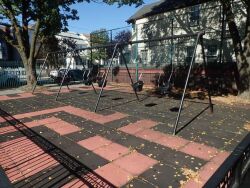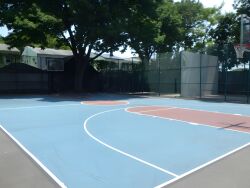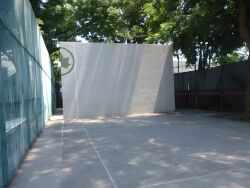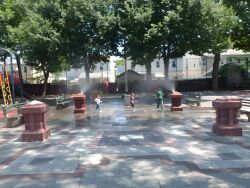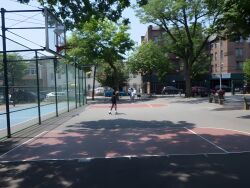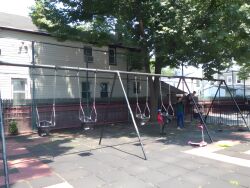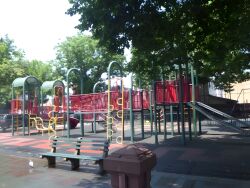Harvard Playground
Harvard Playground
This playground takes its name from Harvard University, the oldest institution of higher learning in the United States. The university was founded in 1636, only 16 years after the arrival of the Pilgrims at Plymouth. Located in Cambridge, Massachusetts, Harvard was named in 1638 for its first benefactor, John Harvard, a minister from Charlestown, Massachusetts who bequeathed half of his estate and his library to the school two years after its founding. Seven United States Presidents have been educated at Harvard and the school remains a prestigious research university to this day.
Playgrounds first appeared in the 1880s as "sand gardens," located on the grounds of settlement houses. Furnished with innovative play equipment like seesaws, and staffed by trained recreation specialists, the playground was designed to be a "healthful influence upon morals and conduct." As Teddy Roosevelt (1858-1919), President of the Playground Association of America, wrote: "If we would have our citizens contented and law-abiding, we must not sow the seeds of discontent in childhood by denying children their birthright of play." For these reformers, recreation was not an end in itself: it was directly linked to the preservation of social morality.
Groups such as the New York Society for Parks and Playgrounds formed to raise awareness of the importance of play for children's health. The Society organized parades of mothers and babies, planned public meetings to demonstrate the use of the see-saw, and opened its own playground on Second Avenue and 91st Street. In 1903, the first municipally-run playground in the United States, Seward Park, opened on the Lower East Side.
In the Depression era of the 1930s, federal aid through the Works Progress Administration enabled the city to expand and improve its play spaces. Under the stewardship of Parks Commisioner Robert Moses (1888-1981), new playgrounds were constructed at an astonishing rate throughout the decade. Moses was able to harness the massive manpower of the Parks Department, whose ranks had swollen to more than 80,000 workers due primarily to the influx of federal money. When Moses took over in 1934, there were only 119 playgrounds in New York City. By 1960, the end of the Moses reign at the Parks Department, there were 777.
Typically, these playgrounds were characterized by large areas of asphalt adorned with sandboxes, seesaws, metallic jungle gyms and monkey bars, swing sets and slides. They were designed for the use of a wide age group, from small children to those of early adolescence. Moses's playground construction program greatly benefited many overcrowded city neighborhoods.
The City obtained this parkland by condemnation on August 20, 1936. The property was formerly composed of two lots owned by Phoebe E. Voelkle and M.L. Rourke, who were paid $12,500 and $27,500, respectively, for their land. The playground opened on July 10, 1937 and, in 1998, Council Member Archie Spigner funded a $898,000 renovation of the park that changed the playground into its current form.
Check out your park's Vital Signs
Clean & Safe
Green & Resilient
Empowered & Engaged Users
Share your feedback or learn more about how this park is part of a
Vital Park System

